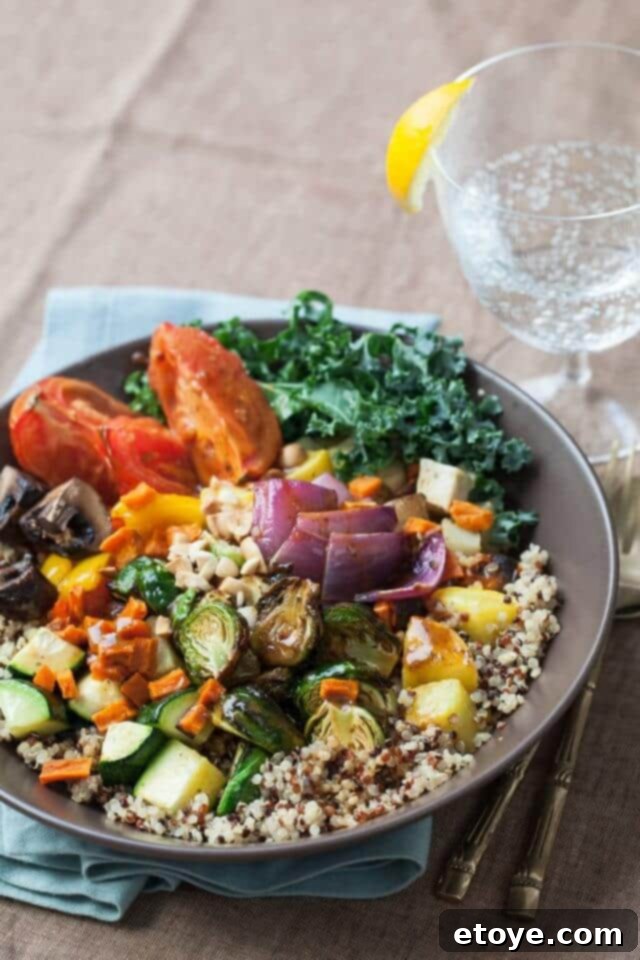
Unlock the secrets to crafting the perfect Roasted Vegetable Buddha Bowl with this comprehensive guide, where you’ll discover:
- Expert techniques for roasting a variety of vegetables simultaneously, ensuring every piece reaches perfect tenderness.
- The incredible flexibility and convenience of Buddha Bowls for advanced meal preparation, allowing you to create a nutritious meal in under 30 minutes.
- Creative ways to personalize your Buddha Bowl using a diverse range of San-J gluten-free cooking sauces and dressings.
What Exactly Are Buddha Bowls?
Have you ever encountered the culinary delight known as a “Buddha Bowl”? These vibrant, nutrient-packed bowls have taken the healthy eating world by storm, and for good reason. At its core, a Buddha Bowl is a generously sized serving of nutritious ingredients, predominantly fresh or roasted vegetables, elegantly arranged over a hearty bed of whole grains. The intriguing name is said to originate from the bowl’s appearance—piled so high with a colorful medley of wholesome goodness that it resembles the rounded, content belly of Buddha.
My own journey into the world of Buddha Bowls began through a wonderful friendship with Cheri of The Watering Mouth, a former assistant at Steamy Kitchen. Cheri and I shared a common ground in Sarasota, Florida, where she’d regularly contribute to creating, testing, and videoing recipes for this site. Fate, it seems, had a plan for us, as we both eventually found ourselves settling in Las Vegas – I for family, and she for her passion for rock climbing.
Cheri is a dedicated nutritarian, a philosophy centered on guiding individuals toward food choices that offer maximum nutrition and health benefits. Naturally, Buddha Bowls form a significant part of her daily meals. They are not only incredibly healthy but also offer unparalleled versatility, making them an ideal solution for quick and nutritious weekday lunches and dinners.
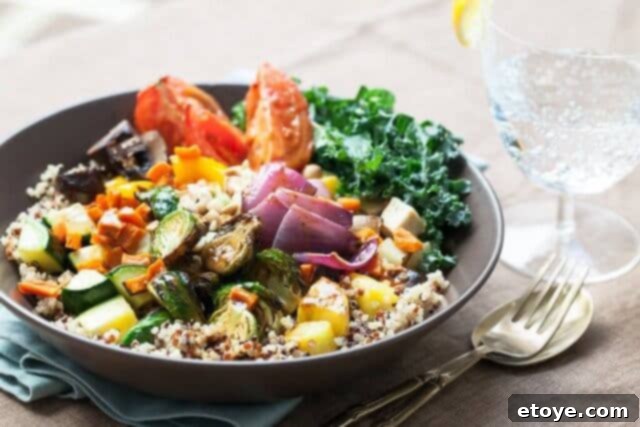
The Irresistible Allure of Buddha Bowls: Why They’ll Become Your New Favorite Meal
Buddha Bowls aren’t just a fleeting food trend; they represent a mindful approach to eating that prioritizes both health and convenience. Here’s why you’ll undoubtedly fall in love with them:
- **Ultimate Customization:** Enjoy the freedom to select precisely the vegetables you crave. Whether you prefer vibrant bell peppers, tender broccoli, earthy mushrooms, or sweet potatoes, the choice is entirely yours. This personalization ensures every meal is a delight.
- **Effortless Meal Prep:** Imagine roasting all your favorite vegetables in a single batch, then storing them in the refrigerator for quick assembly throughout the week. This makes meal preparation incredibly efficient, saving you precious time on busy days.
- **Versatile Serving Temperatures:** Buddha Bowls are wonderfully adaptable. Savor them warm, straight from the oven, or enjoy them at room temperature for a refreshing and light meal, especially on warmer days.
- **Protein Power-Up (Optional):** If your diet includes animal protein, these bowls easily accommodate. Enhance your Buddha Bowl with convenient additions like store-bought rotisserie chicken, a handful of cooked cocktail shrimp, or a perfectly pan-seared salmon fillet.
- **Family-Friendly Dining:** Buddha Bowls are a fantastic solution for families with diverse tastes. Each family member can craft their own personalized bowl, selecting their preferred ingredients, choosing their favorite San-J sauce or dressing, and creating a perfectly balanced and delicious meal that caters to individual preferences.
Elevating Your Buddha Bowl with Perfect Asian Sauces and Dressings: Introducing San-J
At Steamy Kitchen, we are incredibly selective about our brand partnerships. We typically collaborate with only one or two clients annually, as we believe in forging long-term relationships exclusively with products we genuinely adore, integrate into our daily cooking routines, and trust implicitly for their quality and flavor.
This year, we are proud to partner with San-J, a distinguished brand renowned for its exceptional range of Asian tamari soy sauce, as well as a variety of Asian gluten-free cooking sauces and dressings. Their commitment to quality and authentic flavor aligns perfectly with our culinary philosophy.
San-J’s rich heritage dates back to 1804 in Mie, Japan, where it originated as a revered Tamari soy sauce and miso company. Their journey to America began in the 1970s, culminating in the establishment of a brewing facility in Henrico, Virginia, in 1987. The San-J family of tamari soy sauces has garnered immense popularity, particularly for its unique composition: their tamari contains 100% soy, completely free of wheat. This distinction not only makes it a fantastic gluten-free option but also contributes to its notably richer, more complex, and less salty flavor profile compared to conventional soy sauces.

For our delectable Roasted Vegetable Buddha Bowls, we are specifically highlighting San-J’s ready-to-use cooking sauces and marinades. These convenient, flavor-packed options are perfect for enhancing your bowl with minimal effort.
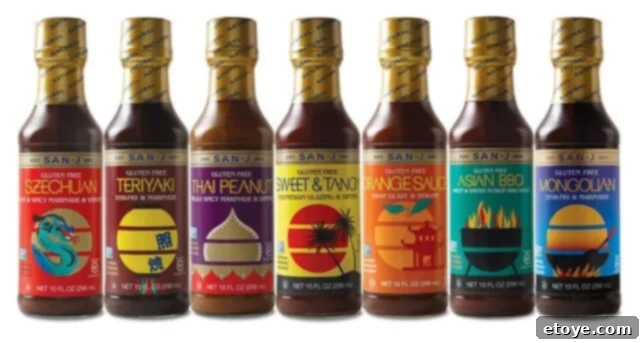
San-J offers an impressive selection of seven distinct and delicious flavors, all proudly certified gluten-free, kosher, and non-GMO. Their diverse range ensures there’s a perfect sauce for every palate and every Buddha Bowl creation.
Now that we’ve explored the wonders of Buddha Bowls and the excellence of San-J, let’s dive into the practical steps. We’ll start by mastering the art of roasting vegetables for these bowls, and then I’ll guide you on how to ingeniously incorporate San-J sauces to truly personalize and elevate your culinary creations.
The Art of Simultaneous Roasting: How to Cook Diverse Vegetables to Perfection
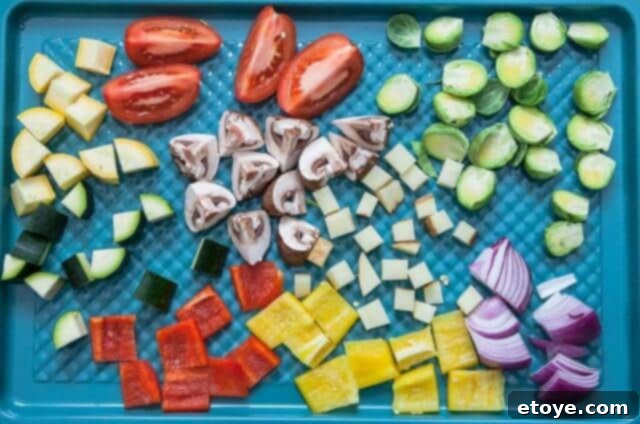
One of the most valuable techniques for efficient meal prep, especially for Buddha Bowls, is learning to roast various types of vegetables all at once. The secret to achieving perfectly cooked results for every vegetable, avoiding both mushiness and undercooked firmness, lies in the consistency of your cuts. Soft, thinly textured ingredients, like bell peppers, naturally cook much faster than dense, hard vegetables such as sweet potatoes. To ensure all your vegetables reach optimal tenderness simultaneously, it’s crucial to adjust your cutting method according to the vegetable’s density and cook time. Our goal is to have everything perfectly tender and slightly caramelized without any component being over or underdone.
We’re aiming for a consistent 20-minute cook time at 375°F (or 350°F for convection ovens). To achieve this harmony, I categorize vegetables into three distinct cut sizes:
Large Cut (Slower Roasters, Higher Water Content)
These are typically larger, fleshy, or juicier vegetables and fruits that require a more substantial cut to prevent them from becoming too soft or watery during the 20-minute roast. They can withstand longer cooking times without losing their structure.
- Medium Roma Tomatoes: Quarter them. Roma tomatoes are preferred over regular varieties due to their firmer flesh and lower water content, which helps them hold their shape and concentrate their flavor beautifully when roasted.
- Cherry Tomatoes: Leave them whole. Their small size and thin skin allow them to roast perfectly without needing to be cut.
- Grapes: Keep them whole. Roasting grapes brings out an unexpected sweetness and subtle tang, making them a fantastic addition to savory dishes or even served alongside a cheese platter. Try them with Brussels sprouts!
- Figs: Halve them. Roasting figs intensifies their natural sweetness and creates a wonderfully jammy texture.
- Asparagus: Snap off the tough, woody ends and leave the spears whole. Their slender shape allows them to cook quickly.
Medium Cut (Most Common Vegetables)
For the majority of your chosen vegetables, aim for pieces approximately 1.5 to 2 inches (4-5 cm) in size. This cut ensures they cook through evenly and develop a lovely caramelization.
- Bell Peppers: Cut into 2-inch squares. This size prevents them from wilting too quickly while allowing them to sweeten and soften.
- Zucchini: Cut into substantial chunks. Zucchini has a high water content, so larger chunks help maintain its texture.
- Mushrooms: Halve button mushrooms or quarter larger varieties. Roasting mushrooms deepens their umami flavor and creates a satisfying texture.
- Brussels Sprouts: Halve smaller sprouts and quarter larger ones. The cut sides will beautifully caramelize.
- Broccoli & Cauliflower: Cut into 1.5-inch florets. These cruciferous vegetables benefit from smaller pieces for even cooking and crisp edges.
- Onions: Cut into 2-inch chunks, trying to keep the layers together as much as possible for visual appeal and a sweeter roast.
- Green Beans: Trim the ends and cut into 2-inch pieces. They’ll retain a slight snap after roasting.
- Leeks: Slice into 2-inch pieces on a diagonal. This exposes more surface area for flavor development.
Small Dice (Hard, Dense Vegetables & Tofu)
Hard, dense root vegetables and ingredients with high water content require a smaller cut, specifically a 1/2-inch (1.25 cm) dice, to ensure they become tender within the 20-minute roasting window.
- Beets: These earthy root vegetables benefit from a small dice for even cooking and concentrated sweetness.
- Potatoes: A 1/2-inch dice allows potatoes to crisp up beautifully while becoming fluffy inside.
- Sweet Potatoes: Like regular potatoes, sweet potatoes are dense. A small dice ensures they cook thoroughly and become wonderfully sweet and tender.
- Butternut Squash: This firm squash needs a small dice to soften properly.
- Turnip: Often overlooked, roasted turnip is delicious when cut into small dice.
- Tofu: Despite being soft, tofu has a very high water content. Cutting the block into small 1/2-inch to 3/4-inch dice allows the water to evaporate, resulting in deliciously firm and slightly crispy pieces after roasting.
Mastering the Sweet Potato Dice: A Step-by-Step Guide
Achieving perfectly roasted sweet potato dice is all about the technique. Here’s a simple breakdown:
First, begin by peeling your sweet potato entirely. Then, slice it into uniform 1/2-inch planks. Consistency here is key for even cooking.
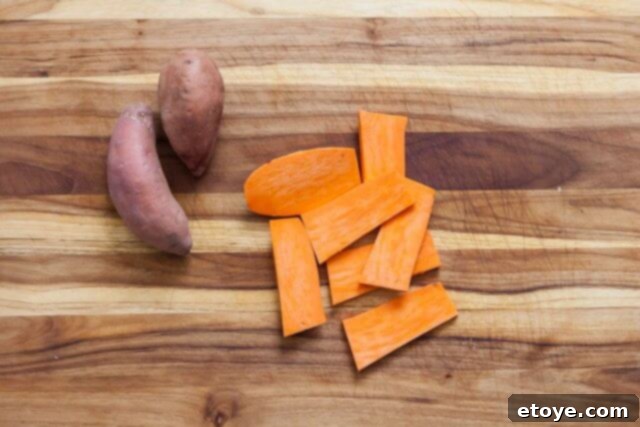
Next, take each plank and cut it into “fries.” You’re essentially creating long, narrow strips about 1/2 inch thick.

Finally, gather your “fries” and dice them. For sweet potatoes, aim for pieces that are 1/2 inch or even slightly smaller. Remember, sweet potatoes are denser than regular potatoes, so smaller pieces ensure they cook through within our target time. For regular potatoes, you might opt for a slightly larger dice, as they tend to be less dense and cook a bit faster.
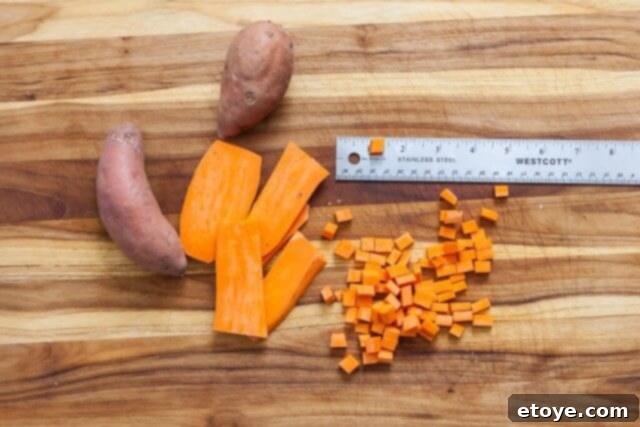
Roasting Your Vegetables: Tips for Optimal Flavor and Texture
The roasting process is where the magic happens, transforming simple vegetables into deliciously caramelized components for your Buddha Bowl. Here are crucial tips for success:
I find it beneficial to keep different types of vegetables grouped together on the baking tray. This strategic placement allows for easy monitoring. If, for instance, a softer vegetable like bell pepper is cooking faster than expected, you can simply use a spatula or large spoon to remove it from the roasting pan a few minutes early, ensuring it doesn’t get overcooked while the denser vegetables finish up.
Crucially, avoid salting the vegetables *before* roasting. Salt has a tendency to draw moisture out of vegetables. If there’s too much moisture accumulated in your pan, your vegetables won’t roast; they’ll steam, leading to a soggy, rather than crispy, outcome. Our aim is a dry-roast, which promotes beautiful browning and a superior texture. Additionally, ensure your vegetables are spread in a single layer with ample space between them. Overcrowding the pan is another common mistake that leads to steaming instead of roasting. If necessary, use multiple baking sheets to give your vegetables the room they need to truly caramelize.
Roast your vegetables at 375°F for approximately 20 minutes. If you have a convection oven, a slightly lower temperature of 350°F often yields the best results, as convection heat is more efficient and even.

When finished, your roasted vegetables should be tender on the inside with a delightful golden-brown exterior, cooked through perfectly and ready to be enjoyed.

Flavor Infusion: Tossing Your Roasted Vegetables with San-J Sauces and Dressings
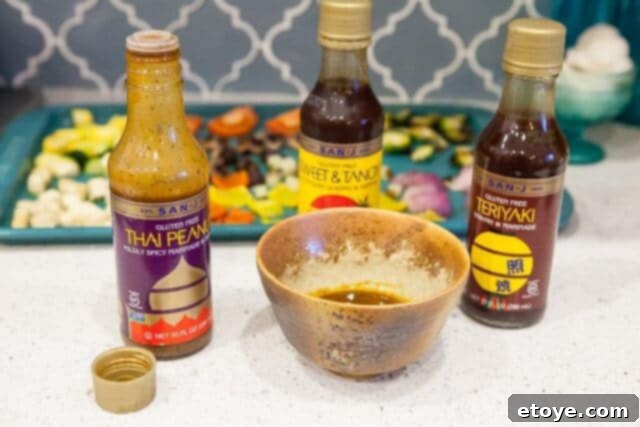
Once your vegetables are beautifully roasted, it’s time to infuse them with incredible flavor using San-J’s versatile sauces and dressings. While you certainly can toss all the vegetables with a single sauce for a cohesive flavor profile, a more engaging and personalized approach, especially for family meals, is to allow each individual to customize their own Buddha Bowl.
To do this, I recommend spooning about 2 tablespoons of your chosen San-J sauce into a small bowl. For an enhanced experience, briefly microwave it for about 10 seconds to gently warm it, which helps to awaken and meld the flavors. Then, toss your portion of roasted vegetables directly with this warmed sauce. Each family member can follow the same simple steps for their own bowl, making the meal an interactive and highly customizable experience.
Beyond their fantastic cooking sauces, San-J also offers a delightful selection of gluten-free salad dressings. These include the savory Tamari Sesame, the rich Tamari Peanut, and the zesty Tamari Ginger. Any of these dressings can be a wonderful alternative to a cooking sauce, adding a different dimension of flavor to your Buddha Bowl.
To easily locate these incredible products, utilize San-J’s convenient product locator. Simply enter your zip code, and it will guide you to stores near you that carry San-J products.
Make Your Bed: Selecting the Perfect Base for Your Buddha Bowl
The foundation of any great Buddha Bowl is its “bed”—a hearty and nutritious base that complements the roasted vegetables and sauces. This provides substance and adds another layer of flavor and texture. Here are some excellent choices:
- Rice: A classic and versatile base.
- White, Brown, or Wild Rice: Each offers a distinct texture and flavor. While I swear by my rice cooker, you can also effortlessly cook white rice in the microwave, or learn how to cook brown rice in the microwave for a quicker option.
- Pasta: Don’t limit yourself to traditional grains!
- Explore fun pasta shapes, like tulips, to add a playful touch to your bowl.
- For gluten-free options, I recently discovered and loved Red Lentil Pasta from Walmart.
- Companies like Modern Table specialize in pastas made from various beans, offering a protein-rich, gluten-free alternative.
- Couscous: An excellent choice when time is short, as it cooks incredibly fast and absorbs flavors beautifully.
- Asian Noodles: Introduce an authentic Asian flair.
- Dried Noodles: Options like Japanese soba, Chinese egg noodles, or dried rice noodles provide a chewy and satisfying base.
- Korean “Japchae” Noodles: Made from sweet potato, these glass noodles are a wonderfully chewy and naturally gluten-free choice.
- Fresh Asian Noodles: Flat rice noodles or fresh egg noodles cook in less than 5 minutes, perfect for busy weeknights.
- Legume-Based Noodles: Explore innovative options like edamame or adzuki bean noodles for a boost of plant-based protein.
- Vegetable “Noodles” or Zoodles: A light, low-carb alternative.
- These are spirals of vegetables like zucchini, carrots, or sweet potatoes. Check out my comparison video of different spiralizers to find the best tool for you.
- My personal favorite is the Inspiralizer, but for those on a budget, I highly recommend this basic spiralizer.
- Fresh Greens: For a lighter, salad-style Buddha Bowl.
- Create a crisp bed with chopped romaine lettuce, delicate baby lettuces, or peppery arugula for a refreshing twist.
- Nutrient-Rich Whole Grains: Power-packed and full of fiber.
- Quinoa: A complete protein, quinoa is an excellent choice. I particularly enjoy the multi-color quinoa for its visual appeal and nutty flavor.
- Spelt: This ancient grain offers a chewy texture. It’s best to soak spelt overnight to reduce its cooking time.
- Barley: Known for its robust flavor and chewy consistency, barley is fantastic when cooked in vegetable broth for added depth. Expect about 40 minutes of cooking time.
- Bulgur: A fast-cooking and flavorful grain, bulgur is perfect for quick meals. I’m a big fan of the Bob’s Red Mill brand.
- Farro: With its delightful, nutty flavor and chewy texture, farro makes an excellent base. Bon Appetit provides a perfect recipe for cooking this ancient grain.
- Freekeh: This smoky, nutritious grain is one of my absolute favorites! Seek out cracked freekeh at your local health food store. Here’s a guide on how to cook it to perfection.
Elevating Your Buddha Bowl with Perfect Toppings
Toppings are the crowning glory of any Buddha Bowl, adding crucial layers of texture, flavor, and often, an extra nutritional boost. They transform a simple bowl into a truly gourmet experience.
We absolutely adore finishing our Buddha Bowls with a sprinkle of nuts. Their satisfying crunch and healthy fats complement the tender vegetables beautifully. However, the possibilities for toppings are endless. Consider adding:
- Freshness & Crunch: Finely shredded lettuce or cabbage, crisp radish slices, julienned carrots, or cucumber ribbons.
- Herbs: Freshly chopped cilantro, parsley, mint, or basil for a burst of aromatic flavor.
- Sprouts: A handful of alfalfa, bean, or broccoli sprouts for a delicate crunch and added nutrients.
- Seaweed: Shredded nori or toasted sesame seaweed snacks for an umami-rich, savory element.
- Seeds: Toasted sesame seeds, sunflower seeds, pumpkin seeds, or chia seeds for texture and healthy fats.
- Avocado: Sliced or diced avocado adds creamy richness and healthy monounsaturated fats.
- Fermented Foods: Kimchi or sauerkraut for a tangy, probiotic boost.
- Crispy Shallots or Onions: For an irresistible savory crunch.
For my personal Buddha Bowl today, I’m pairing the roasted vegetables with San-J’s exquisite Thai Peanut Sauce. To further enhance the experience, I’ve added a generous sprinkling of roasted, chopped peanuts, providing an extra layer of delightful crunch and reinforcing the nutty flavors of the sauce. This combination is a testament to how simple additions can elevate the entire dish.

Roasted Vegetable Buddha Bowl
Ingredients
- 1 large zucchini
- 2 roma tomatoes
- 1/2 pound brussels sprouts
- 1/2 red onion
- 1 bell pepper
- 8 large mushrooms
- 4 ounce extra-firm tofu
- 1 small potato
- 1 small sweet potato
- 3 tablespoon olive oil
- Lettuce, whole grain, pasta or rice of your choice – enough for 4 servings
- Cooking sauce or salad dressing of your choice, we recommend San-J brand
- Handful of nuts, if desired, as a topping
Instructions
- Preheat your oven to 375°F (190°C). If using a convection oven, set to 350°F (175°C).
- Wash, peel, trim, and cut all your chosen vegetables according to the specific sizes detailed in the “How to roast different vegetables at the same time” section of this article. Arrange the cut vegetables in a single layer on a large baking sheet or roasting pan, ensuring they are not overcrowded. Drizzle evenly with olive oil. Roast for 20 minutes until tender and lightly caramelized.
- While the vegetables are roasting, prepare your base. Cook your preferred whole grains, pasta, noodles, or rice according to package instructions. Alternatively, prepare a bed of fresh lettuce or mixed greens if you prefer a lighter base.
- Once the vegetables are perfectly roasted, remove them from the oven. In individual bowls, toss a portion of the warm vegetables with about 2 tablespoons of your chosen San-J cooking sauce or salad dressing. You’ll likely find that no additional salt is needed, thanks to the robust flavor of the sauces. Serve the sauced vegetables over your prepared base. If desired, garnish with a handful of nuts or other preferred toppings for added texture and flavor. Enjoy your custom-made, nutritious Buddha Bowl!
